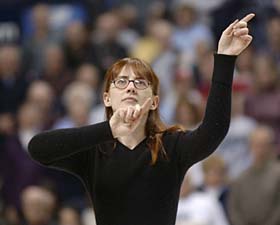For more archives, go to the Advance Archive/Search Page.
Silence Is Rule In
American Sign Language Classes
Doreen Simons-Marques discusses an exam with her students, but she doesn't say a word. They, in turn, ask her questions, but the classroom is silent.
 |
|
Raechel Stalnaker, who took ASL classes as an
undergraduate at UConn and now works part-timein the linguistics lab, signs
the national anthem before a women's basketball game at Gampel Pavilion earlier
this season. Photo by Peter Morenus
|
That's because they are using their hands and faces to communicate their ideas: they're learning American Sign Language, or ASL.
ASL is offered through the critical languages program in the Department of Modern and Classical Languages. First and second-year courses are available, as well as more advanced courses through tutored study. ASL also satisfies the University's requirement for a foreign language.
In the classroom, Simons-Marques signs to a student. "That was a good try," she says to the woman, who used the word 'broke' incorrectly. The student and several classmates giggle.
"A machine is broken, or you can be broke and have no money," Simons-Marques signs, explaining the difference between the two words, which have completely different signs.
Except for a clap of a hand or a stomp on the floor, ASL classrooms are quiet. And that's the rule, says Simons-Marques, who was born deaf and does not speak. "Students can talk to me or to each other," she says, "but they can use only American Sign Language."
Many students are interested in learning ASL, which is one of the most widely used languages in the United States. "Some students want to eventually work with the deaf community as sign language interpreters, teachers of the deaf, social workers, or speech or language therapists," says Diane Lillo-Martin, professor and head of the linguistics department. "Others are simply fascinated by the language." There is a demand among students to expand the program, she notes.
Each fall, about 25 students enroll in ASL I, the beginning sign language course.
In addition to learning sign language, students learn about what it is like to be deaf in a hearing world, and about the close-knit deaf community, their shared experiences, pride, and social life. "We discuss myths about the deaf community," Simons-Marques says. "Some people think we don't have the same intelligence as people who can hear. Yet deaf people can do everything but hear."
ASL has its own grammatical structure, where a big part of the vocabulary involves words with many morphemes, or small pieces of words with meanings. It's a distinct and different language from English. Facial expressions, including the raising or lowering of the eyebrows, and body movements are integral parts of communicating . They help give meaning to what is being signed, just as intonation and inflection help clarify spoken words, Lillo-Martin says.
Laura Labato, a senior majoring in human development and family studies, has taken ASL for three years. "I've always been interested in it," she says. "It's such an expressive and visual language." Since last year, Labato, along with other students, has been signing the national anthem at basketball games in Gampel Pavilion. One person is positioned on the court floor to sign next to the singer, and other students stand along the concourse to sign to the people in upper level seating.
"It has been a great opportunity for us, both to learn new vocabulary to sign the national anthem, and to perform the song in front of such a large audience," Labato says. "We hope the Huskies fans also enjoy our presentation and become more aware of American Sign Language."
Raechel Stalnaker, who works part time in the linguistics lab, says ASL has helped her overcome her shyness. "I had to sign in front of the class, and at first I was really nervous," says Stalnaker, who also signs the national anthem at Gampel. "When you first start ASL, you're going to be embarrassed, but then you laugh and move on."
Stalnaker, who graduated from UConn in 2003, continues to take ASL and helps students in beginning classes.
James Weingart, an eighth-semester computer science major, decided to take ASL because his younger brother is deaf.
"I like learning new vocabulary," he says.
Stuart Soboleski, who was born deaf, learned to sign as a child. "I learned ASL as any other child would have learned a spoken language," he says. "I decided to take ASL to learn more about my own language. I wanted to learn the rules and proper grammar, not to mention more about my own culture," he says. A fourth semester special education major, Soboleski says he wants to dispel some of the myths about people who are deaf. "Many people look at us like we have a disability," he says, "but I want them to know we can do things: I can be a student at UConn, get a bachelor's, a master's, and a Ph.D. A lot of people don't realize that."
Soboleski is president of the ASL Club at UConn and has recently been elected Undergraduate Student Government multicultural and diversity senator. The ASL Club recently organized its first "Deaf Awareness Week at UConn." Events included a lecture by Soboleski on 'audism' - a term that describes misconceptions held by both the deaf and the hearing population about deaf people - "looking at our ears rather than at us as people," he says; a talk on deaf culture by Simons-Marques; and a play performed by students from the American School for the Deaf in West Hartford.

